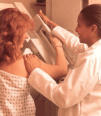|
|
|
Mammograms Prevenir es Vida
|
|

MammogramA mammogram is an x-ray test that produces an image of the inner breast tissue on film. This technique, called mammography, is used to visualize normal and abnormal structures within the breasts. Mammography, therefore, can help in identifying tumors within the breast. It is currently the most effective way to detect early breast cancer. Breast self- examination (BSE) on a monthly basis and examination by a doctor are still important, but physical examinations typically find breast cancers when they are much larger than those detected by mammography. While mammography can discover a small cancer in a curable stage it not foolproof. Ten to fifteen percent of breast cancers are not identified by mammography and these cancers are found by physical examination. It is essential for a woman to perform monthly BSE and have a breast examination by her doctor in addition to the mammogram in order to most effectively screen for breast cancer. The American Cancer Society and the American College of Surgeons currently recommend that a woman obtain her first baseline mammogram between the ages of 35 to 40. Between the ages of 40 to 50 a mammogram should be done every other year. After the age of 50, a mammogram should be repeated yearly. Women who are at high risk for developing breast cancer may need to obtain mammograms earlier than these recommendations and at more frequent intervals. What are the risks of a mammogram? How is a Mammogram preformed? All jewelry and clothing in the chest and breast area are removed prior to the mammogram. The patient's breasts are then placed on a firm flat x-ray surface and a gentle, but firm pressure is applied to the breast using a mammogram compression device. This compression can cause a degree of discomfort in some women, but it is usually a painless procedure. The compression of the breast is very important in obtaining quality mammograms. The compression spreads the breast tissue out so that the x-rays display the inner breast tissue with good resolution. If compression is not used, the mammograms may be blurry, breast tissue may not be well delineated, and small lesions can be missed. Generally, two x-rays are obtained of each breast. More views may be obtained if the breasts are large, the woman has had a breast augmentation, or there is an area on the initial mammography views that needs to be further examined. Special magnified or localized mammograms of a specific area of the breast can then be done. A radiology technologist is responsible for performing the mammogram. Once the x-ray pictures are taken, they are developed and examined by a radiologist (a doctor who specializes in the interpretation of x-rays). In most mammogram centers, these radiologists have also had extra training in interpreting mammograms.
Links: To find out where you can get a free or low-cost mammogram visit the Centers for Disease Control and Prevention site. Visit the National Cancer Institute to understand screening mammograms further. To find our more about mammograms visit ourbodiesourselves.org a site that provides information in English and in Spanish. Works Cited: Medicinenet.com . 5/6/02
|
|||||||
| This site was created by Charlene Ruiz in fulfillment of requirements for the course CSS 335: Latino Health Issues taught by Dr. Szkupinski Quiroga at Arizona State University, Spring 2004. |